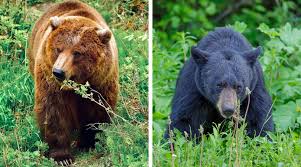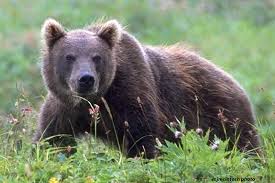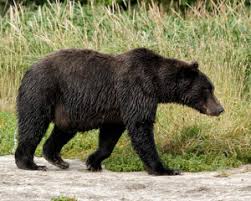Bears, scientifically known as Ursidae, are fascinating creatures that roam various habitats across the world. These powerful mammals are known for their distinctive appearance, characterized by a robust build, sharp claws, and a keen sense of smell.
In the wild, black bears, a common bear species, exhibit a wide range of coat colors, including black, brown, and even white. Despite their name, not all black bears are black; some can be brown, cinnamon, or blonde. These adaptable animals are found in North America, where they inhabit forests, mountains, and even urban areas, showcasing their ability to coexist with humans.
Grizzly bears, another notable species within the bear family, are larger and renowned for their iconic hump on their shoulders. Scientifically classified as Ursus arctos horribilis, these mighty creatures are distributed across North America, with distinct populations inhabiting different regions. Grizzly bears play a crucial role in maintaining ecological balance, influencing plant and animal populations within their territories.
Bears are omnivores, meaning they consume both plant and animal matter. Their diet varies based on seasonal availability, ranging from berries, nuts, and grasses to fish and small mammals. This versatility in diet contributes to their survival in diverse environments.
Hibernation is a remarkable aspect of bear behavior. During winter, when food becomes scarce, bears enter a state of dormancy to conserve energy. This period allows them to survive harsh conditions without needing to hunt for food. Black bears and grizzly bears both engage in hibernation, showcasing their remarkable adaptation to changing seasons.
In terms of reproduction, female bears, known as sows, give birth to cubs in dens during hibernation. Cubs are born blind, hairless, and entirely dependent on their mothers for care and nourishment. The bond between a bear mother and her cubs is strong, emphasizing the nurturing nature of these creatures.
Human-bear conflicts are an ongoing concern, often arising from habitat encroachment and improper food disposal. Understanding and respecting bear habitats, along with adopting responsible behavior in bear country, are crucial steps in mitigating these conflicts and ensuring the conservation of these magnificent animals.
Additionally, bears, with their scientific name Ursidae, are captivating mammals that play vital roles in ecosystems. From the adaptable black bears to the imposing grizzly bears, these creatures showcase the wonders of nature through their diverse behaviors and ecological contributions. Understanding and appreciating bears contribute to their conservation and the preservation of the delicate balance of our natural world.
Read Also: Importance of Poultry Management Practices
Plants and Animals Affected by Bears (Ursidae)

Bears, with their presence and activities, can influence the ecosystem and impact various plants and animals within their habitats. Their interactions create a ripple effect, shaping the dynamics of the environment.
Plants:
1. Berries and Fruits: Bears are opportunistic feeders, and they play a crucial role in seed dispersal. They consume berries and fruits, and the undigested seeds are later dispersed through their feces. This process contributes to the spread and regeneration of plant species.
2. Vegetation: Bears can affect vegetation by foraging for roots, tubers, and plant bulbs. Their digging behavior helps in nutrient cycling and soil aeration. However, excessive foraging can also impact local plant populations.
3. Trees: In certain habitats, bears are known to scratch trees with their claws, leaving visible marks. While this behavior might cause minimal harm to the tree, it can serve as a territorial marking for bears.
Animals:
1. Fish: Many bear species, particularly grizzly bears, are skilled fishers. They catch fish from rivers and streams, influencing fish populations. This interaction is vital for maintaining aquatic ecosystems and nutrient cycling.
2. Insects: Bears may disturb insect populations while digging for grubs, ants, or other invertebrates. This activity can impact insect communities in the soil and contribute to nutrient cycling.
3. Small Mammals: Bears may prey on small mammals, affecting their populations. This predation can influence the dynamics of rodent and other small mammal communities in bear-inhabited areas.
4. Birds: Some bird species benefit from the activities of bears, especially those that feed on the insects and fruits disturbed by bears while foraging. Additionally, bears may indirectly create habitat features (like deadfall) that certain bird species utilize.
5. Scavengers: Bears are known to leave remains of their kills or unfinished meals. This provides a valuable food source for scavengers such as ravens, eagles, and other opportunistic animals.
While bears play essential roles in maintaining ecological balance, it is crucial to manage human-bear interactions carefully to minimize negative impacts on both wildlife and human communities. Conservation efforts that consider the interconnectedness of species within ecosystems help ensure the well-being of plants and animals affected by bears.
Damages Caused by Bears

Bears, while essential to ecosystems, can sometimes cause damages, especially in interactions with human activities. Understanding these potential impacts is crucial for managing coexistence and minimizing conflicts. Here are some damages associated with bears:
1. Agricultural Damage: Bears may be attracted to crops such as corn, oats, and fruits. Agriculture can suffer losses when bears feed on these crops, leading to economic impacts for farmers.
2. Beehives: Bears are known to raid beehives in search of honey and bee larvae. This behavior can result in damage to beehives, affecting beekeepers’ livelihoods and the pollination services provided by bees.
3. Livestock: In some cases, bears may prey on livestock, particularly calves or sheep. This can result in financial losses for farmers and ranchers, as well as potential conflicts between bear conservation and livestock protection.
4. Property Damage: Bears, when searching for food, may damage property such as dumpsters, bird feeders, and storage sheds. Their powerful claws and teeth can easily break into structures, causing inconvenience and financial losses.
5. Vehicles: Bears can cause damage to vehicles, especially when attracted by food smells. They might break into cars or campers in search of food, causing both property damage and potential safety concerns.
6. Human Safety Concerns: While bears generally avoid humans, conflicts can arise in areas where human activities overlap with bear habitats. This can lead to safety concerns, and in extreme cases, human injuries. Proper bear awareness and safety measures are essential to mitigate these risks.
7. Tourism Impact: In areas where bears are a tourist attraction, improper human behavior, such as getting too close to bears or feeding them, can lead to habituation. Habituated bears may lose their natural fear of humans, potentially leading to aggressive behavior, and can impact the overall tourist experience.
It’s important to note that these damages are often a result of human-bear conflicts, and effective management strategies involve educating the public, implementing proper waste disposal practices, and establishing bear-resistant containers to reduce attractants. Conservation efforts aim to strike a balance that ensures the well-being of both bears and the communities they inhabit.
Read Also: Importance of Multivitamins in Poultry Production
Control and Preventive Measures

Controlling and preventing conflicts between bears and humans involves a combination of proactive measures and responsible practices. Here are key strategies for managing human-bear interactions:
1. Bear-Resistant Containers: Implementing bear-resistant containers for garbage disposal is crucial. This helps prevent bears from accessing human food waste, reducing the likelihood of bears becoming habituated to human-related food sources.
2. Education and Outreach: Public awareness campaigns are essential to educate communities about bear behavior, safety measures, and the importance of minimizing attractants. This includes proper food storage, securing trash, and avoiding leaving food unattended in outdoor areas.
3. Bear-Proofing Property: Securing beehives, chicken coops, and livestock areas with electric fencing can deter bears from causing damage. Additionally, installing bear-resistant doors and windows in cabins or storage sheds can help prevent break-ins.
4. Harvest Management: In areas where bears may impact agricultural activities, proper harvest management practices can help minimize conflicts. Timely harvesting and efficient crop removal reduce opportunities for bears to access crops.
5. Wildlife Corridors: Establishing and maintaining wildlife corridors allows bears to travel between habitats without encountering extensive human development. This helps preserve natural migration routes and reduces the likelihood of bears entering populated areas.
6. Tourism Guidelines: Implementing responsible tourism guidelines is crucial in bear habitats. Educating tourists about maintaining a safe distance from bears, avoiding direct interaction, and not feeding wildlife helps prevent habituation and ensures a positive experience for both humans and bears.
7. Research and Monitoring: Continuous research and monitoring of bear populations and their behaviors contribute to effective management strategies. Understanding local bear dynamics enables authorities to make informed decisions for both conservation and public safety.
8. Collaboration with Communities: Collaboration between wildlife management authorities, local communities, and conservation organizations is vital. Engaging communities in bear management plans, seeking input, and fostering a sense of shared responsibility contribute to successful coexistence.
9. Bear-Proofing Campsites: Campers and outdoor enthusiasts should be encouraged to use bear-resistant food containers and follow proper camping practices. This includes storing food securely, cleaning cooking utensils thoroughly, and disposing of waste responsibly.
10. Legal Protection: Enforcing and strengthening regulations that prohibit the feeding of bears and emphasize responsible behavior in bear habitats is essential. Legal protection ensures that both humans and bears are safeguarded.
Implementing a comprehensive approach that combines these measures is key to fostering harmonious coexistence between bears and human communities. By addressing the root causes of conflicts and promoting responsible practices, it is possible to mitigate damages and protect both bear populations and the well-being of local communities.
Frequently Asked Questions (FAQs) About Bears (Ursidae)
1. Q: What should I do if I encounter a bear in the wild?
A: Stay calm, avoid direct eye contact, speak in a calm voice, and back away slowly without turning your back on the bear. Do not run, as this may trigger a chase response.
2. Q: Can bears be found in urban areas?
A: Yes, some bear species, like black bears, have adapted to living near urban environments. It’s important to secure garbage, avoid leaving food out, and take preventive measures to reduce human-bear conflicts.
3. Q: Do bears hibernate?
A: Yes, many bear species hibernate during winter to conserve energy when food is scarce. However, not all bears hibernate, and the duration may vary depending on factors such as climate and food availability.
4. Q: What do bears eat?
A: Bears are omnivores and have diverse diets. They consume berries, fruits, nuts, vegetation, fish, insects, and occasionally prey on small mammals. Their diet varies based on seasonal availability.
5. Q: How fast can bears run?
A: Bears are surprisingly fast runners. Depending on the species, they can reach speeds of 30 miles per hour or more in short bursts. It’s essential to give bears plenty of space to avoid triggering defensive behaviors.
6. Q: Are bears dangerous to humans?
A: While bears generally avoid humans, conflicts can arise. It’s crucial to follow safety guidelines, such as maintaining a safe distance, securing food, and being aware of your surroundings in bear country.
7. Q: Why are bears important for ecosystems?
A: Bears play a vital role in ecosystems by influencing plant and animal populations. They contribute to seed dispersal, nutrient cycling, and control prey populations, helping maintain a balanced and healthy environment.
8. Q: Do bears have a good sense of smell?
A: Yes, bears have an excellent sense of smell, often considered one of the best among land animals. Their acute olfactory abilities help them locate food sources over long distances.
9. Q: How long do bear cubs stay with their mothers?
A: Bear cubs typically stay with their mothers for about 1.5 to 3 years, depending on the species. During this time, the mother teaches them essential survival skills.
10. Q: Can bears climb trees?
A: While black bears are skilled climbers, grizzly bears are not as proficient. However, both species can climb trees, especially when they are young or trying to escape a threat.
Read Also: How to Manage Your Finances

